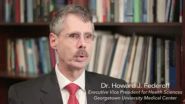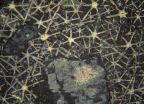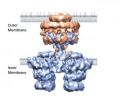(Press-News.org) CHESTNUT HILL, MA (March 10, 2014) – In a relatively recently discovered class of materials, known as spin-orbit Mott insulators, theorists have predicted the emergence of new properties at points just beyond the insulating state, when electronic manipulation can transform these compounds into conducting metals.
A better understanding of electrons near this transition, theorists have predicted, could allow these new Mott insulators to pave the way to discoveries in superconductivity, new topological phases of matter, and new forms of unusual magnetism.
What scientists have lacked is experimental evidence that reveals the microscopic mechanisms that actually drive one of these spin-orbit Mott insulators to become a metal.
Now a team of physicists at Boston College report in Nature Communications that they manipulated a compound of strontium, iridium and oxygen – Sr3Ir207 – with a substitution of ruthenium metal ions, successfully driving the material into the metallic regime, and mapping this previously uncharted transformation as it took place, giving scientists a unique view into the workings of these insulators.
Spin-orbit Mott insulators are so named because of their complex electronic properties. Within these novel materials, there is a repulsive interaction between electrons that tends to drive the electrons to a stand still. This tendency is bolstered by the lowering of the electron's energy via a strong interaction between the electron's magnetic field and its orbital motion around the nucleus.
This delicate interplay between repulsive action, known as Coulomb interaction, and the coupling between electrons' spin and orbital motion has allowed scientists to define this class of materials as spin-orbit Mott insulators.
Boston College Assistant Professor of Physics Stephen D. Wilson said the team succeeded in driving the insulator-to-metal transformation by replacing 40 percent of the iridium ions with ruthenium, thereby creating a metal alloy. That event introduced charge carriers, which have proven successful in destabilizing the so-called Mott phase in the transformation of compounds in this class of insulators.
Scanning tunneling microscopy revealed ruthenium effectively created features within the compound that resembled minute metallic puddles, said Wilson, one of the lead researchers on the project. As the amount of additional ruthenium was increased, the puddles began to "percolate," coalescing to form a metal across which charges freely flow, he added.
"The addition of ruthenium introduces charge carriers, but at a low ratio of ruthenium to iridium they simply stay put in these little metallic puddles, which are symptoms of strong correlated electrons," Wilson said. "These electrons are stable and wouldn't move much. But when we stepped up the disruption by increasing the amount of ruthenium, the puddles moved together and achieved a metallic state."
The behavior in this particular compound parallels what researchers have seen in Mott insulators that play host to such phenomenon as high temperature superconductivity, said Wilson, who will discuss his research at the upcoming annual meeting of the American Physical Society.
By pinpointing exactly where this transformation takes place, the team's findings should help to lay the groundwork in the scientific search for new electronic phases within spin-orbit Mott insulators, said Wilson, who co-authored the report with his Boston College Department of Physics colleagues Professor Vidya Madhavan, Professor Ziqiang Wang, and Assoc. Prof. Fr. Cyril P. Opeil, SJ.
INFORMATION:
BC graduate students Chetan Dhital, the lead author of the paper, Tom Hogan, Wenwen Zhou, Xiang Chen, Zhensong Ren, Mani Pokharel, and M. Heine also contributed to the project.
Scientists at the Oak Ridge National Laboratory, the U.S. National Institute of Standards and Technology and the Canadian Center for Neutron Research also collaborated on the research.
Mapping the behavior of charges in correlated spin-orbit coupled materials
Electronic disruption prods Mott insulator's conversion to metallic state
2014-03-10
ELSE PRESS RELEASES FROM THIS DATE:
Farm salmon pose clear reproductive threat to wild gene pools
2014-03-10
Farmed salmon show full reproductive potential to invade wild gene pools and should be sterilised - according to new research from the University of East Anglia (UEA).
Findings published today reveal that, while farmed salmon are genetically different to their wild counterparts, they are just as fertile. This is important information because millions of farmed salmon escape into the wild – posing threats to wild gene pools.
Lead Researcher Prof Matt Gage from UEA's school of Biological Sciences said: "Around 95 per cent of all salmon in existence are farmed, and domestication ...
UEA research reveals 4 new man-made gases in the atmosphere
2014-03-09
Scientists at the University of East Anglia have identified four new man-made gases in the atmosphere – all of which are contributing to the destruction of the ozone layer.
New research published today in the journal Nature Geoscience reveals that more than 74,000 tonnes of three new chlorofluorocarbons (CFCs) and one new hydrochlorofluorocarbon (HCFC) have been released into the atmosphere.
Scientists made the discovery by comparing today's air samples with air trapped in polar firn snow – which provides a century-old natural archive of the atmosphere. They also looked ...
Blood test identifies those at-risk for cognitive decline, Alzheimer's within 3 years
2014-03-09
VIDEO:
Howard J. Federoff, M.D., Ph.D., of Georgetown University Medical Center, explains a new blood test that can predict onset of MCI or Alzheimer's.
Click here for more information.
WASHINGTON — Researchers have discovered and validated a blood test that can predict with greater than 90 percent accuracy if a healthy person will develop mild cognitive impairment or Alzheimer's disease within three years.
Described in Nature Medicine published online today, the study heralds ...
Mutations in leukemia gene linked to new childhood growth disorder
2014-03-09
Mutations in a gene associated with leukaemia cause a newly described condition that affects growth and intellectual development in children, new research reports.
A study led by scientists at The Institute of Cancer Research, London, identified mutations in the DNA methyltransferase gene, DNMT3A, in 13 children.
All the children were taller than usual for their age, shared similar facial features and had intellectual disabilities. The mutations were not present in their parents, nor in 1,000 controls from the UK population.
The new condition has been called 'DNMT3A ...
First animals oxygenated the ocean, study suggests
2014-03-09
The evolution of the first animals may have oxygenated the earth's oceans – contrary to the traditional view that a rise in oxygen triggered their development.
New research led by the University of Exeter contests the long held belief that oxygenation of the atmosphere and oceans was a pre-requisite for the evolution of complex life forms.
The study, published today in the leading journal Nature Geoscience, builds on the recent work of scientists in Denmark who found that sponges – the first animals to evolve – require only small amounts of oxygen.
Professor Tim ...
In grasslands remade by humans, animals may protect biodiversity
2014-03-09
COLLEGE PARK, Maryland – A comparative study of grasslands on six continents suggests there may be a way to counteract the human-made overdose of fertilizer that threatens to permanently alter the biodiversity of the world's native prairies.
The solution is one that nature devised: let grazing animals crop the excess growth of fast growing grasses that can out-compete native plants in an over-fertilized world. And grazing works in a way that is also natural and simple. The herbivores, or grazing and browsing animals, feed on tall grasses that block sunlight from reaching ...
New bioinformatics tool to visualize transcriptomes
2014-03-09
ZENBU, a new, freely available bioinformatics tool developed at the RIKEN Center for Life Science Technology in Japan, enables researchers to quickly and easily integrate, visualize and compare large amounts of genomic information resulting from large-scale, next-generation sequencing experiments.
Next-generation sequencing has revolutionized functional genomics, with protocols such as RNA-seq, ChIP-seq and CAGE being used widely around the world. The power of these techniques lies in the fact that they enable the genome-wide discovery of transcripts and transcription ...
Sun's energy influences 1,000 years of natural climate variability in North Atlantic
2014-03-09
Changes in the sun's energy output may have led to marked natural climate change in Europe over the last 1000 years, according to researchers at Cardiff University.
Scientists studied seafloor sediments to determine how the temperature of the North Atlantic and its localised atmospheric circulation had altered. Warm surface waters flowing across the North Atlantic, an extension of the Gulf Stream, and warm westerly winds are responsible for the relatively mild climate of Europe, especially in winter. Slight changes in the transport of heat associated with these systems ...
Spread of antibiotic resistance understood by unravelling bacterial secretion system
2014-03-09
The system that allows the sharing of genetic material between bacteria – and therefore the spread of antibiotic resistance – has been uncovered by a team of scientists at Birkbeck, University of London and UCL.
The study, published today in Nature, reveals the mechanism of bacterial type IV secretion, which bacteria use to move substances across their cell wall. As type IV secretion can distribute genetic material between bacteria, notably antibiotic resistance genes, the mechanism is directly responsible for the spread of antibiotic resistance in hospital settings. ...
Atomically thin solar cells
2014-03-09
It does not get any thinner than this: The novel material graphene consists of only one atomic layer of carbon atoms and exhibits very special electronic properties. As it turns out, there are other materials too, which can open up intriguing new technological possibilities if they are arranged in just one or very few atomic layers. Researchers at the Vienna University of Technology have now succeeded for the first time in creating a diode made of tungsten diselenide. Experiments show that this material may be used to create ultrathin flexible solar cells. Even flexible ...
LAST 30 PRESS RELEASES:
Safety decision-making for autonomous vehicles integrating passenger physiological states by fNIRS
Fires could emit more air pollution than previously estimated
A new way to map how cells choose their fate
Numbers in our sights affect how we perceive space
SIMJ announces global collaborative book project in commemoration of its 75th anniversary
Air pollution exposure and birth weight
Obstructive sleep apnea risk and mental health conditions among older adults
How talking slows eye movements behind the wheel
The Ceramic Society of Japan’s Oxoate Ceramics Research Association launches new international book project
Heart-brain connection: international study reveals the role of the vagus nerve in keeping the heart young
Researchers identify Rb1 as a predictive biomarker for a new therapeutic strategy in some breast cancers
Survey reveals ethical gaps slowing AI adoption in pediatric surgery
Stimulant ADHD medications work differently than thought
AI overestimates how smart people are, according to HSE economists
HSE researchers create genome-wide map of quadruplexes
Scientists boost cell "powerhouses" to burn more calories
Automatic label checking: The missing step in making reliable medical AI
Low daily alcohol intake linked to 50% heightened mouth cancer risk in India
American Meteorological Society announces Rick Spinrad as 2026 President-Elect
Biomass-based carbon capture spotlighted in newly released global climate webinar recording
Illuminating invisible nano pollutants: advanced bioimaging tracks the full journey of emerging nanoscale contaminants in living systems
How does age affect recovery from spinal cord injury?
Novel AI tool offers prognosis for patients with head and neck cancer
Fathers’ microplastic exposure tied to their children’s metabolic problems
Research validates laboratory model for studying high-grade serous ovarian cancer
SIR 2026 delivers transformative breakthroughs in minimally invasive medicine to improve patient care
Stem Cell Reports most downloaded papers of 2025 highlight the breadth and impact of stem cell research
Oxford-led study estimates NHS spends around 3% of its primary and secondary care budget on the health impacts of heat and cold in England
A researcher’s long quest leads to a smart composite breakthrough
Urban wild bees act as “microbial sensors” of city health.
[Press-News.org] Mapping the behavior of charges in correlated spin-orbit coupled materialsElectronic disruption prods Mott insulator's conversion to metallic state






